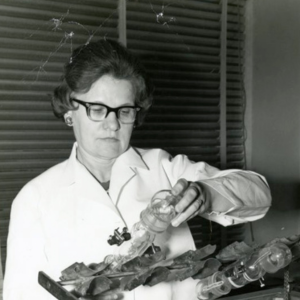Ruth Benerito (NC ’35)

Contributions
by Cara Becker (LA ’15) and Chloe Raub (NC ’07)
This article was originally published in NEWCOMB Magazine on October 24, 2016.
Ruth Rogan Benerito enrolled at Newcomb College at the age of 15, graduating with a B.A. in Chemistry in 1935 and almost immediately after earning her M.S. from Tulane University in the same field. Benerito later received her doctorate from the University of Chicago, also in chemistry. Her success was fueled by the camaraderie and encouragement of Newcomb College. She was mentored in the lab by Newcomb alumna Dr. Rose Mooney (NC ’26) and later by Clara de Milt (NC ’11), another alumna and then head of the Department of Chemistry, who later hired Benerito to teach at Newcomb and to build up the Department’s collaborative research efforts. Benerito worked as a professor of physical chemistry at Newcomb for ten years, simultaneously earning her doctorate over summer breaks and leaves of absence. She rose within the department and upon de Milt’s death in 1953 was offered the position of head of the Department of Chemistry. Benerito declined the promotion, choosing to seek innovation beyond the walls of academia.
Her success as an academic was enough to make her stand out, considering the scarcity of women educated in the sciences in the first half of the twentieth century. However, it was her entrance into the world of textile sciences that made her name widely known. Benerito started working for the U.S. Department of Agriculture’s Southern Regional Research Laboratory in 1953, where she began experimenting with cotton fabric. It was there that her most widely recognized contribution to the field of chemistry took place: her research on cross-linking in cotton molecules was one of the prime chemical revelations that led to the invention of permanent press (or wrinkle-free) fabric, as well as stain and flame-resistant cotton fabrics. While many collaborated on this effort, as Benerito herself often admitted, it truly was Benerito’s research that made the discovery possible. As noted by The New York Times, she said that wrinkle-free cotton was the result of teamwork.
“I don’t like it to be said that I invented wash-wear, because there were any number of people working on it, and there are various processes by which you give cotton those properties,” she said. “No one person discovered it or was responsible for it. But I contributed to new processes of doing it.”
Her achievements skyrocketed as her career in chemistry continued, gaining her over fifty patents and an array of prestigious awards, including the Lemelson-MIT Award for Invention and Innovation, as well as induction into the National Inventors Hall of Fame in 2008. Benerito remained with the U.S.D.A. until retiring in 1986, after which she joined the faculty of the University of New Orleans and continued teaching until the age of 81. Even as her career grew, her life remained in New Orleans, always connected to the innovation that a Newcomb education inspired.
Benerito passed away in 2013 at the age of 97. Her nephew, William Rogan, donated records of her lectures, manuscripts, patent files, honors, and awards, with the hope that researchers might find a complete record of Benerito’s accomplishments at a single repository. Archival staff are now working to process the collection, approximately seven linear feet of records.
